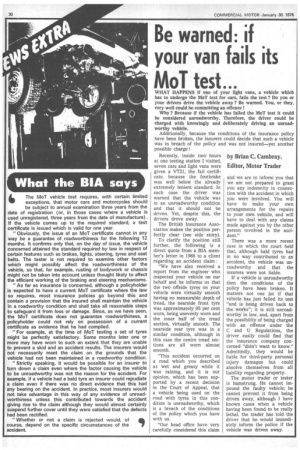The MoT vehicle test requires, with certain limited exceptions, that
Page 32

If you've noticed an error in this article please click here to report it so we can fix it.
motor cars and motorcycles should be subject to annual examination three years from the date of registration (or, in those cases where a vehicle is used unregistered, three years from the date of manufacture). If the vehicle comes up to the required standard, a test certificate is issued which is valid for one year.
" Obviously, the issue of an MoT certificate cannot in any way be a guarantee of roadworthiness for the following 12 months. It confirms only that, on the day of issue, the vehicle concerned attained the standard required by law in respect of certain features such as brakes, lights, steering, tyres and seat belts. The tester is not required to examine other factors which might possibly affect the roadworthiness of the vehicle, so that, for example, rusting of bodywork or chassis might not be taken into account unless thought likely to affect the efficient working of the braking and steering mechanisms.
" As far as insurance is concerned, although a policyholder is expected to have a current MoT certificate where the law so requires, most insurance policies go beyond this and contain a provision that the insured shall maintain the vehicle in a roadworthy condition and shall take all reasonable steps to safeguard it from loss or damage. Since, as we have seen, the MoT certificate does not guarantee roadworthiness, a policyholder could not rely on possession of a current certificate as evidence that he had complied.
" For example, at the time of MoT testing a set of tyres might be perfectly satisfactory. Some months later one or more may have worn to such an extent that they are unable to prevent a skid and an accident results. The insurers would not necessarily meet the claim on the grounds that the vehicle had not been maintained in a roadworthy condition.
"Strictly speaking, it would be possible for an insurer to turn down a claim even where the factor causing the vehicle to be unroadworthy was not the reason for the accident. For example, if a vehicle had a bald tyre an insurer could repudiate a claim even if there was no direct evidence that this had any bearing on the accident. In practice, most insurers would not take advantage in this way of any evidence of unroadworthiness unless this contributed towards the accident giving rise to the claim although they would almost certainly suspend further cover until they were satisfied that the defects had been rectified.
"Whether or not a claim is rejected would, of course, depend on the specific circumstances of the accident.
































































































